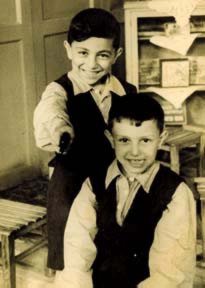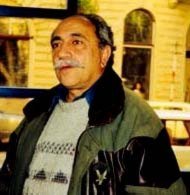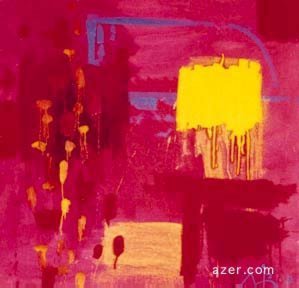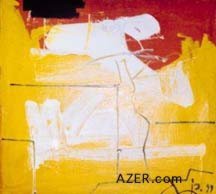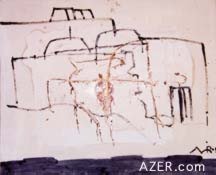|
Winter
1999 (7.4) Famous People:
Then and Now
Mir Nadir at age 5 in 1948 and in 1999. Mir Nadir Zeynalov (pronounced mir-na-DIR zey-NA-lov) is among those Azerbaijani artists who have successfully made the transition from the Socialist Realism style of the Soviet period to a freer abstract style now that country has gained its independence and artists are able to more fully express their inner world. He studied art at the Azim Azimzade Arts Institute in Baku, then went on to study at the Moscow Polygraphic Institute. His paintings are featured on the Internet at: AZgallery.org. He may be contacted in his studio in Baku at (99-412) 69-13-89 or 53-12-57. What experiences and interests in childhood would you say shaped your life and career?
Photos: Recent contemporary works by Zeynalov, 1990s. I started drawing in kindergarten when I was four or five years old. I used to draw wars and scenes from my imagination and would show them to my parents. Both of them encouraged me even though there weren't any artists in our family. My father had wanted to become a writer but when the war broke out, he had to go into business instead. My mother was a doctor - a lung specialist. Many of my father's friends were poets like Vahid and Vurghun and artists like Khalig. I think my father felt like a poet inside and that's why he gravitated to such people. He would introduce me to his friends and show them my works. My mother also recognized my artistic talent, and so my parents enrolled me in the Pioneers' House beginning in first grade where there was a teacher named Masuma Sultanova, who taught us the basics of painting. She was like a mother, not a teacher, because she was so kind. Later on, I had another wonderful instructor - Latif Feyzullayev. He taught me so much about the use of color during the five years that I studied with him. My grandfather also played an important role in my life. He used to take me on long walks to various villages. He would teach me all kinds of things, for example, the various kinds of trees and how old they were, the benefits they could give to people. He wasn't an artist but he was a very sensitive person. At night, he would hug us three brothers and put us to sleep telling bedtime stories from our national folktales and literature. This may also have affected my art. Primarily, I think it helped develop my inner spirit at a very early age. A significant moment in my early development was when I painted a picture called "Melons in the Sand." There are many gardens on the Absheron Peninsula where melons grow. At that time in my classes, we were only painting with water colors, but I ventured out with oils anyway. It was my very first oil painting. I soon discovered that I had a tremendous appetite for colors. It seemed that I could never get enough colors; I always wanted more. How was your own childhood different from that of kids growing up today? I think today's kids watch too much TV and spend too much time playing with computers. These things make young people passive; it keeps them from experiencing and discovering things in nature first hand. They sit inside their homes separated from real life. When I was growing up, we didn't have TV or computers, so we had to invent our own games. We were much closer to nature. My own son, for example, sits inside four walls and draws pictures on the computer. I'd rather that he buy a canvas and go outside and work beside a tree under the sun. Sure, the computer is necessary as well, but you shouldn't become isolated and separated from nature. During the Soviet period, children spent more time outside their homes, playing with other kids at school or in the street. Nowadays, parents don't want their kids to pick up bad habits from the other children. So they pick up their children from school and take them directly home. But problems at home can stifle initiative and imagination. Kids become frustrated and the result is that eventually they grow up alone. In addition, families are having fewer children these days so there aren't so many brothers and sisters for them to play with. My father used to say: Let the child be strong, don't spoil him too much at home. Let him go out and play with other children. Don't be afraid that something is going to happen to him. Let him quarrel and fight with other kids. Let him develop deep independent friendships because they will make him strong. What advice would you give to young people as they enter the 21st century? Although I'm not sure I'm old enough to advise young people, I suppose I would tell them to focus on their work and to pursue it wholeheartedly. That means to work in only one direction - "Don't try," as we say, "to carry ten watermelons in one hand." Try to be the best that you can in one single field. Be focused. Young people today don't know what they want to do, so they experiment with too many different things. Then they leave them incomplete and give up. I have a younger relative who used to take violin lessons when he was a child. He wanted to quit but his parents wouldn't let him. Today he is a famous violinist. Now he says, "God bless my parents for making me do this. Otherwise, I would have wasted my time." A kid doesn't always know what's best for him. As for young artists, I would tell them that a true artist loves nature and is always in contact with it. Nature is like a balance - everything can be tested against it. Once I heard an artist say that you could test an art work by placing it in nature, near the sea and rocks. If people spent time looking at it in that setting, then they would be willing to look at it elsewhere as well. If not, then you should get rid of it. There are some places in nature, such as the Absheron, that give me great power. Sometimes I see a place and understand that I must paint there. Afterwards, I feel like I've gained a great power that was not dependent on me - whether it was the sea, the desert, a tree or a rock. The place itself has a soul that attracts me and the spirit of that place gives me power. Sometimes when I feel tired and my creative power seems extinguished, my heart tells me to sit in a certain place and start to paint. Once I go there, I feel my strength being renewed. What would you say is your greatest achievement in life? What do you want to be remembered for most? I'm a simple artist. Let others judge my works. After I'm gone, only my works will remain - if they remain. Everything that I've created is close to my soul. I can't differentiate between my works by saying that one is better than the other. All of them represent the "energy" of my inner life. All works and paintings have to give off an energy - positive energy - because energy is the only thing that lasts forever. It's the only thing that affects people. Even after the creator has passed away, that energy will live for generations in his works.
|

